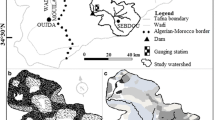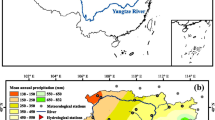Abstract
Purpose
The temporal variabilities of both soil erosion by water and sediment redistribution in watersheds are directly related to rainfall characteristics. The purpose of this work was to assess the temporal pattern of rainfall in a semiarid watershed in Brazil and explain how this feature controls soil erosion and sediment yield.
Materials and methods
Daily and 5-min rainfall records were used to assess the temporal pattern down to the sub-hourly scale. To study the effect of the rainfall on sediment processes, erosivity and sediment yield at the Aiuaba (12 km2) and Benguê (933 km2) watersheds, Brazil were determined. Erosivity was calculated based on the rainfall kinetic energy method, while sediment yield was estimated from sediment rating curves and daily water discharge measurements.
Results and discussion
A large portion of annual rainfall is restricted to a few rain events and strong concentration in the sub-daily scale occurs, producing high erosivity. The temporal concentration of erosivity is greater than that of rainfall; the 10th percentile of the highest magnitude events encompasses 51% of the precipitation, but 80% of the erosivity. The temporal concentration of sediment yield is more pronounced; 88 and 98% of the sediment yield for the Aiuaba and Benguê watersheds, respectively, are within the 10th percentile of events.
Conclusions
The strong temporal concentration of precipitation causes events with high intensity and erosivity, thus allowing for soil detachment. Nonetheless, the low runoff rates limit downstream sediment transport. Such behavior produces a much higher temporal concentration of sediment yield, which reaches its maximal after a sequence of rainy days, when hydrological connectivity is enhanced and the sediments are propagated throughout the entire transport-limited system.






Similar content being viewed by others
References
Almeida COS, Amorim RSS, Couto EG, Eltz FLF, Borges LEC (2010) Potencial erosivo da chuva de Cuiabá, MT: Distribuição e correlação com a precipitação pluviométrica. Rev Bras Eng Agríc Ambient 15:178–184
Angima SD, Stott DE, O'Neill MK, Ong CK, Weesies GA (2003) Soil erosion prediction using RUSLE for central Kenyan highland conditions. Agr Ecosyst Environ 97:295–308
Arnaud P, Lavabre J, Fouchier C, Diss S, Javelle P (2011) Sensitivity of hydrological models to uncertainty in rainfall input. Hydrol Sci J 56(3):397–410
Bahadur KCK (2009) Mapping soil erosion susceptibility using remote sensing and GIS: a case of the Upper Nam Wa Watershed, Nan Province, Thailand. Environ Geol 57:695–705
Bonilla CA, Vidal KL (2011) Rainfall erosivity in Central Chile. J Hydrol 410:126–133
Carvalho DF, Machado RL, Evangelista AWP, Khoury Júnior JK, Silva LDB (2010) Distribuição, probabilidade de ocorrência e período de retorno dos índices de erosividade EI30 e KE > 25 em Seropédica–RJ. Eng Agríc 30:244–252
de Araújo JC, Medeiros PHA (2013) Impact of dense reservoir networks on water resources in semiarid environments. Aust J Water Res 17(1):87–100
de Araújo JC, Piedra JIG (2009) Comparative hydrology: analysis of a semiarid and a humid tropical watershed. Hydrol Process 23:1169–1178
de Araújo JC, Güntner A, Bronstert A (2006) Loss of reservoir volume by sediment deposition and its impact on water availability in semiarid Brazil. Hydrol Sci J 51:157–170
Dias AS, Silva JRC (2003) A erosividade das chuvas em Fortaleza (CE). I—distribuição, probabilidade de ocorrência e período de retorno—1a aproximação. Rev Bras Ciênc Solo 27:335–345
Eltaif NI, Gharaibeh MA, Al-Zaitawi F, Alhamad MN (2010) Approximation of rainfall erosivity factors in North Jordan. Pedosphere 20:711–717
Figueiredo JV (2011) Início da geração de escoamento superficial em uma bacia semiárida em Caatinga preservada. Masters Dissertation, Federal University of Ceará, Department of Agricultural Engineering, Brazil
Foster GR, McCool DK, Renard KG, Moldenhauer WC (1981) Conversion of the Universal Soil Loss Equation to SI metric units. J Soil Water Conserv 36:355–359
Frischkorn H, de Araújo JC, Santiago MMF (2003) Water resources of Ceará and Piauí. In: Gaiser T, Krol M, Frischkorn H, de Araújo JC (eds) Global change and regional impacts. Springer, Berlin, pp 87–94
Funceme—Meteorological and Water Resources Foundation of Ceará (2012) www.funceme.br. Accessed 10 Feb 2012
Haregeweyn N, Melesse B, Tsunekawa A, Tsubo M, Meshesha D, Balana BB (2012) Reservoir sedimentation and its mitigating strategies: a case study of Angereb reservoir (NW Ethiopia). J Soils Sediments 12:291–305
Hoyos N, Waylen PR, Jaramillo A (2005) Seasonal and spatial patterns of erosivity in a tropical watershed of the Colombian Andes. J Hydrol 314:177–191
Huang J, Zhang J, Zhang Z, Xu C-Y (2013) Spatial and temporal variations in rainfall erosivity during 1960–2005 in the Yangtze River basin. Stoch Env Res Risk A 27:337–351
Lee JH, Heo JH (2011) Evaluation of estimation methods for rainfall erosivity based on annual precipitation in Korea. J Hydrol 409:30–48
Lima Neto IE, Wiegand M, de Araújo JC (2011) Sediment redistribution due to a dense reservoir network in a large semi-arid Brazilian basin. Hydrol Sci J 56:319–333
López-Vicente M, Lana-Renault N, García-Ruiz JM, Navas A (2011) Assessing the potential effect of different land cover management practices on sediment yield from an abandoned farmland catchment in the Spanish Pyrenees. J Soils Sediments 11:1440–1455
Mannaerts CM, Gabriels D (2000) Rainfall erosivity in Cape Verde. Soil Tillage Res 55:207–212
Medeiros PHA, Güntner A, Francke T, Mamede G, de Araújo JC (2010) Modelling spatio-temporal patterns of sediment yield and connectivity in a semiarid catchment with the WASA-SED model. Hydrol Sci J 55:636–648
Obled C, Wendling J, Beven K (1994) The sensitivity of hydrological models to spatial rainfall patterns: an evaluation using observed data. J Hydrol 159:305–333
Pinheiro EAR, Costa CAG, de Araújo JC (2013) Effective root depth of the Caatinga biome. J Arid Environ 89:1–4
Salako FK (2010) Development of isoerodent maps for Nigeria from daily rainfall amount. Geoderma 156:372–378
Silva AM (2004) Rainfall erosivity map for Brazil. Catena 57:251–259
Slimane AB, Raclot D, Evrard O, Sanaa M, Lefèvre I, Ahmadi M, Tounsi M, Rumpel C, Mammou AB, Le Bissonnais Y (2013) Fingerprinting sediment sources in the outlet reservoir of a hilly cultivated catchment in Tunisia. J Soils Sediments 13(4):801–815
Smith MB, Koren VI, Zhang Z, Reed SM, Pan JJ, Moreda F (2004) Runoff response to spatial variability in precipitation: an analysis of observed data. J Hydrol 298:267–286
Sun Y, Solomon S, Dai A, Portmann RW (2006) How often does it rain? J Clim 19:916–934
Torrico JJT (1974) Práticas hidrológicas. Transcon, Rio de Janeiro, p 119
Wischmeier WH, Smith DD (1978) Predicting rainfall erosion losses—a guide to conservation planning. USDA, Agriculture Handbook 537, Washington DC, USA
Acknowledgments
The authors acknowledge the Brazilian National Council for Scientific and Technological Development (CNPq) for financing the research projects that generated this manuscript (n. 474323/2011-0 and 200672/2012-6), as well as the German Research Foundation (DFG) for the financial support to the research project “Generation, transport and retention of water and suspended sediments in large dryland catchments”. The authors are also grateful to the Federal Institute of Education Science and Technology of Ceará—IFCE for the grant to support research activities.
Author information
Authors and Affiliations
Corresponding author
Additional information
Responsible editor: Jorge Enoch Furquim Werneck Lima
Rights and permissions
About this article
Cite this article
Medeiros, P.H.A., de Araújo, J.C. Temporal variability of rainfall in a semiarid environment in Brazil and its effect on sediment transport processes. J Soils Sediments 14, 1216–1223 (2014). https://doi.org/10.1007/s11368-013-0809-9
Received:
Accepted:
Published:
Issue Date:
DOI: https://doi.org/10.1007/s11368-013-0809-9




